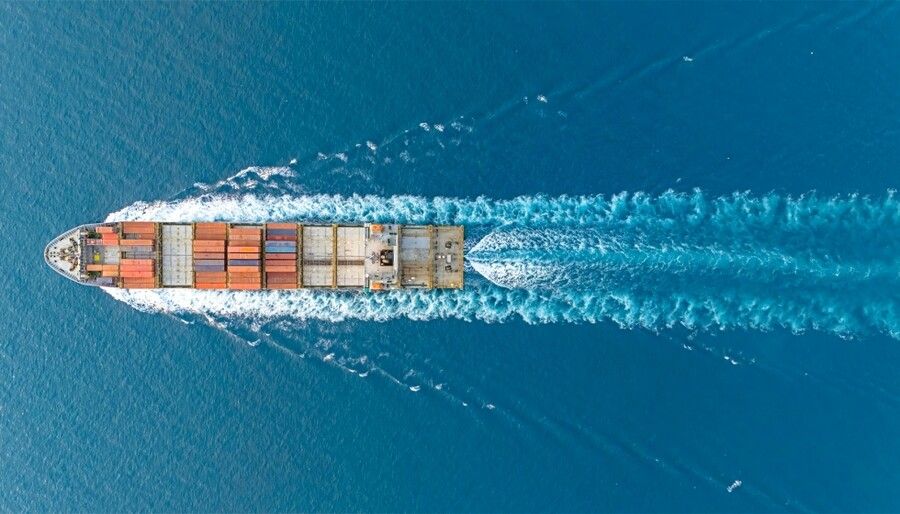New trends in marine propulsion systems: energy efficiency and sustainability as future axes

Alternative fuel engines implementation, hybrid systems and the return of technologies such as rigid sails reflect a growing effort to decarbonise shipping and comply with global environmental regulations.
Shipping remains the global trade main pilar, responsible for the movement of approximately 90% of goods worldwide. However, as environmental awareness increases and international commitments to reduce greenhouse gas emissions become more stringent, shipping sector is faced with the challenge of finding innovative solutions for marine propulsion that balance operational efficiency and sustainability.
Currently, the main trends in marine propulsion systems are aimed at minimising environmental impact and reducing dependence on fossil fuels. This change is being driven by both International Maritime Organisation (IMO) regulations and by increasing market demands to reduce emissions of CO₂, sulphur oxides (SOx) and nitrogen oxides (NOx). New technologies such as hybrid electric motors, alternative fuels like ammonia and hydrogen, and the return of sails are leading the transformation in naval propulsion systems.
Hybrid engines: efficiency and flexibility
Hybrid propulsion systems, which combine internal combustion engines with electric technologies, are rapidly gaining ground in the maritime industry. This technology not only reduces fuel consumption and emissions, but also provides flexibility in using different energy sources depending on operational needs.
Hybrid vessels use batteries to power electric motors in low-speed manoeuvres, such as entering and leaving ports, where energy consumption is relatively low. On the high seas, when the vessel requires greater power, diesel or liquefied natural gas (LNG) engines take over. This system allows for a significant reduction in emissions and improves the overall efficiency of the vessel. In addition, it reduces noise levels, an important factor in sensitive areas, such as coastal zones.
Alternative fuels: the shift towards greater sustainability
Heavy fuel oil progressive abandonment is a trend that has accelerated in recent years, especially following the IMO 2020 regulation implementation, which limits the sulphur content in marine fuels to 0.5%. In this context, several alternative fuels are gaining prominence, including LNG, hydrogen and ammonia.
LNG has been one of the main alternatives to traditional fuel oil, due to its ability to significantly reduce SOx and NOx emissions, as well as suspended particulate matter. In addition, LNG offers a 20% reduction in CO₂ emissions compared to conventional fuels.
Despite its growing popularity, LNG is not a perfect solution. It is still a fossil fuel, and its main drawback is methane emission, a gas with a much more potent greenhouse effect than CO₂. However, it remains an important intermediate option until hydrogen- or ammonia-based technologies mature.
Moreover, hydrogen and ammonia are two of the most promising alternative fuels for shipping, as they do not emit CO₂ during combustion. Both are emerging as long-term solutions for decarbonizing the sector, although they still face technical and economic challenges.
Hydrogen is an attractive option due to its ability to be used in both internal combustion engines and fuel cells, making it a versatile fuel. However, most of the hydrogen currently available comes from fossil sources, so its environmental impact depends largely on how it is produced. Green hydrogen, generated through electrolysis using renewable energy, is the most sustainable option, although it is still expensive and requires considerable infrastructure for storage and distribution.
Ammonia, it also does not produce CO₂ during combustion and has the advantage of being easier to store and transport than hydrogen. In addition, it can be used in adapted engines or fuel cells.
The return of sails: aerodynamics at the service of efficiency
One of the trends re-emerging in marine propulsion is the use of sails, but not traditional fabric ones, but rigid sails or wind-assisted propulsion systems. This technology, combined with conventional engines, makes it possible to take advantage of the wind to reduce fuel consumption and emissions, especially on transoceanic routes where wind conditions are favourable.
Rigid sails, made from advanced materials and designed using aerodynamic principles, generate a propulsion force that complements engine systems.
The challenge of infrastructure
One of the major challenges for mass adoption of these new propulsion technologies is the infrastructure needed to support their development. Alternative fuels such as hydrogen, ammonia or LNG require specialized facilities for their production, storage and distribution, which implies significant investments both on land and in ports.
Likewise, hybrid propulsion systems and electric technologies need charging stations and advanced maintenance for batteries. The expansion of these infrastructures is advancing, but its pace must accelerate to meet the emissions reduction targets established by international organizations.
Source: Interempresas

